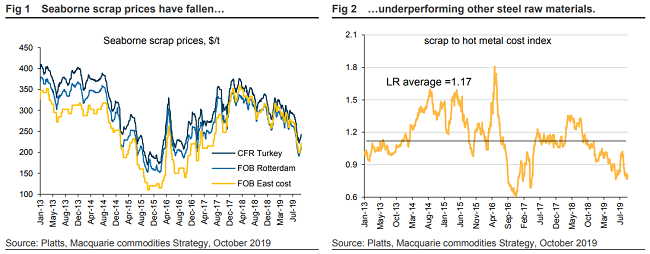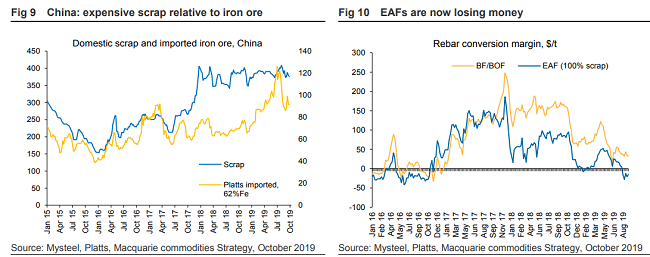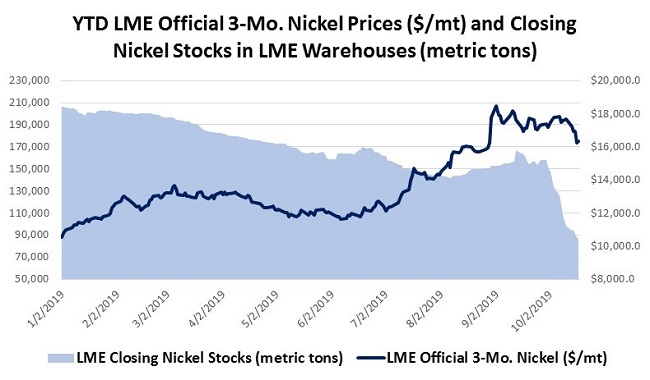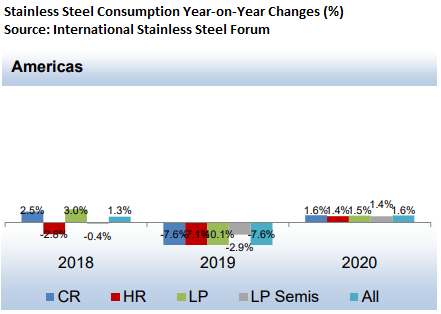Ferrous – Fastmarkets AMM reports that the reinstatement of a 50% tariff on Turkish steel imports into the United States appears to be on hold for now: “U.S. President Donald Trump said this past week that he would revive the 50% tariff on imports of Turkish steel in response to the country's military actions in Northeast Syria.
But the two countries reached an agreement on Thursday October 17, with the US implying that it will refrain from imposing the steel tariff increase if Turkey halts its offensive. ‘Once Operation Peace Spring is paused, the US agrees not to pursue further imposition of sanctions under the executive order of October 14, 2019,’ the White House said in issuing a joint statement with Turkey. The US Commerce Department and White House press office did not respond to Fastmarkets' request for comment on Friday.”
Even if the higher tariff level were imposed, Macquarie Research does not expect much of an impact on ferrous scrap prices given the relative weakness in scrap prices already, the plunge in Turkish steel exports to the U.S., and recent stability of the Turkish lira.

In contrast, Macquarie notes that ferrous scrap prices in China remain elevated compared to other raw material inputs and that Chinese EAFs are now more vulnerable to a downturn in steel prices:

Here in the U.S., the American Iron and Steel Institute reports that for the week ending October 12th, “…domestic raw steel production was 1,821,000 net tons while the capability utilization rate was 78.7 percent. Production was 1,877,000 net tons in the week ending October 12, 2018 while the capability utilization then was 80.1 percent. The current week production represents a 3.0 percent decrease from the same period in the previous year. Production for the week ending October 12, 2019 is up 0.9 percent from the previous week ending October 5, 2019 when production was 1,804,000 net tons and the rate of capability utilization was 78.0 percent.”
Nonferrous – Primary nickel prices were pressured lower at the LME last week even as warehouse stocks continue to be drawn down. On Thursday, LME 3-mo. nickel traded as low as $16,085/mt, down from more than $18,000 per ton in mid-September. At the same time, nickel stocks in LME warehouses have plunged by 80,000 tons over the last month and are down by around 120,000 tons since the start of the year. But as Andy Home from Reuters has written, “This LME stocks grab isn’t a reflection of current market dynamics but is rather about potential future market tightness resulting from the cut in the flow of Indonesian ore to China’s mainland stainless steel producers. It is no secret in the nickel market that a Chinese company has been snapping up LME stocks. Tsingshan Holding Group was the driver of falling stocks in July and is the name in the frame again this time. The stainless steel producer sits at the heart of the supply conundrum thrown up by Indonesia’s accelerated ban on ore exports.”

On a related note, the International Stainless Steel Forum reports that global stainless steel production increased 1.9% in the first half of 2019 as an 8.5% increase in Chinese stainless production more than offset weaker production in Europe (-4.9%) and the U.S. (-6.4%). Looking forward, ISSF is projecting a contraction in stainless steel consumption in the Americas in 2019 and only a modest rebound in 2020.

Recovered Paper – According to the Bureau of International Recycling’s recent press release, “Over the course of the next three to four years, Turkey could provide a home for a significant proportion of Europe’s recovered fibre surplus, it was indicated at the latest meeting of the BIR Paper Division.
By the year 2023, Turkish paper mills are expected to have developed a combined annual production capacity of between 6 and 7 million tonnes. However, the country’s collection rate of around 40% is well below that achieved by many developed countries and “is not increasing”, explained guest speaker Ercan Yürekli from TÜDAM, the national association of Turkish paper and plastic recyclers and collectors. As a result, he calculated, there will be a need for annual imports into Turkey of perhaps 2 to 3 million tonnes of recovered fibre, meaning that the country could provide “a solution for some of Europe’s surplus”.
Under current waste management regulations in Turkey, only recyclers are allowed to import recovered paper whereas collection companies cannot. The country’s imports have soared from just over 300,000 tonnes in 2015 to more than 725,000 tonnes in 2018, with a figure nearer 1 million tonnes anticipated for 2019.
New capacity is also emerging in Sweden, it was reported by divisional Vice President Martin Leander of Stena Metall International AB. At the same time, the insulation and hygiene sectors have been trialling wider use of recovered fibre in their products.
Earlier in the BIR Paper Division’s meeting in Budapest on October 15, the body’s General Delegate Sébastien Ricard of France-based Paprec explained that Europe’s structural surplus of recovered fibre is currently approaching 8 million tonnes per year, with annual collections of 56.7 million tonnes exceeding consumption of 48.8 million tonnes. “So we need exports in Europe,” he emphasised. “We need new markets.”